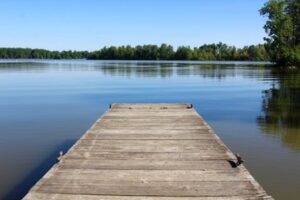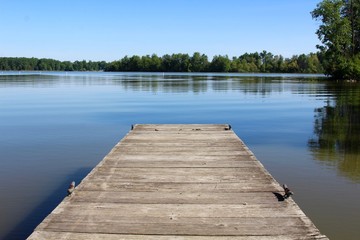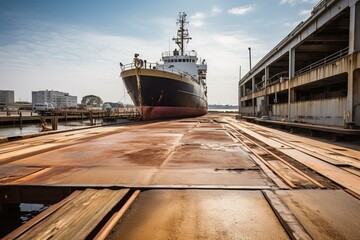A dock enhances the beauty and functionality of a lakefront property. It can be used for boat mooring or as a serene space to relax and enjoy nature.

A professionally-constructed, aesthetically-pleasing dock also increases property value. However, dock building requires much time and effort, not to mention specialized knowledge and skills. Contact Lake Wylie Dock Builder for professional help.
A dock is an excellent investment for anyone living on a waterfront property. It not only eliminates the need to pay for boat storage fees, but it also adds value to your home if you decide to sell it in the future. Plus, it gives you the opportunity to enjoy water activities whenever you want without having to travel.
The first step in designing a floating dock is to understand your waterfront conditions and limitations. A professional dock service can help you evaluate these factors to determine the type and size of a dock that will meet your needs. They can also recommend the best location for your dock based on the shoreline, bottom conditions, and tidal fluctuations.
You should also know if your community has any regulations regarding dock building. For instance, some areas require a permit while others may have restrictions on the construction material or height. In addition, some communities have covenants that regulate the construction of docks on the waterfront. A professional dock service can provide you with all the information you need to build a safe and reliable dock for your lakefront property.
Hiring a professional company for dock building will save you time and effort. In addition, they can offer a warranty for their work, which will give you peace of mind. Choose a company that has years of experience in the business, and one that offers a comprehensive service, from design to installation.
It is important to consider how a dock will affect the environment and your neighbors, especially if you live in an urban area. You will also need to ensure that the dock does not enclose any public water space and does not interfere with navigation. You should also make sure to display your dock ID and maintain a safe distance from other docks and moored boats.
It is also important to note that docks can be energy hogs. This is mainly due to the fact that they are often left open for long periods of time. It is important to install a heating and cooling system in your dock to prevent energy loss.
Increased Value
A dock can add a lot of value to your property. It can increase your home’s resale value by as much as $14,000 to $20,000. While the actual number may vary depending on the size of your dock and the quality of the materials used, it’s still a good idea to invest in one.
A well-constructed, aesthetically pleasing dock can also help to improve the property’s curb appeal. This is particularly important when it comes to waterfront properties, where buyers tend to expect a dock as part of the overall package. It can also add to your property’s rental value, making it an attractive option for potential renters.
When choosing a company to build your dock, look for a team of experienced professionals with years of experience in the industry. This will ensure that your dock is built properly and safely. In addition, a professional company will offer warranties on their work, which gives you peace of mind.
In addition to enhancing your property’s value, a dock can provide you with an ideal spot for recreational activities. You can use it as a retreat from the hustle and bustle of everyday life, or as a space for social gatherings and relaxation. A waterfront dock is also an excellent spot for fishing, swimming, boating, and more. It can be a perfect place to entertain family and friends, or simply relax with a book and a glass of wine.
The structure can be constructed from various materials, such as steel, aluminum, and wood. However, metal is expected to dominate the market in the long run due to its durability and low maintenance costs. Wood, on the other hand, is a traditional material for building docks and is favored by many customers because of its superior natural aesthetics.
Moreover, the increased demand for water transportation across the globe has stimulated the maritime construction industry and the growth of the floating docks market. Floating docks can be built in a variety of shapes and sizes to fit the specific needs of the customer. They can also be designed to support heavy marine traffic, making them an ideal choice for commercial and industrial purposes. Consequently, the demand for these structures is growing rapidly.
Aesthetics
Whether they’re anchored in calm water, or standing on the shoreline, docks are a beautiful element of any lakefront property. With a thoughtful design and the right materials, they can also serve as a social space for relaxation or water-based activities. As such, a premium boat dock is a true asset and can add significant value to your home or business.
Residential docks provide homeowners with direct access to bordering waterways for boating, swimming, fishing, and other forms of recreation. In addition, they’re a convenient way to store boats and equipment and protect them from storm damage. However, choosing a residential dock for your property requires careful planning and attention to detail to ensure that it meets your needs and provides maximum safety and security.
When designing a residential dock for boats, it’s important to choose the best materials that will last. There are many options available, including aluminum, wood, and composites. Each material has its own benefits and drawbacks, but a few key factors to consider are durability, stability, aesthetics, and cost.
It’s also important to consider the size and layout of your dock, as well as the location. A dock that’s too small for your vessel can create an unstable environment that could lead to damage and injuries. On the other hand, a dock that’s too large can be difficult to maneuver in and out of the water.
Aesthetic considerations are equally important for a residential boat dock. The right color and finish can enhance the look of your structure, while also providing safety and longevity. For example, a slip-resistant texture helps prevent injury to bare feet and is crucial for ensuring that your dock is a comfortable and safe place to spend time.
A dock building project is a unique undertaking that involves more than just construction. It’s essential to find a local builder that’s experienced with customizing and installing quality docking systems. A reputable dock builder will understand the unique requirements and regulations of your area and can help you choose a safe and attractive solution that fits your needs.
Safety
In addition to improving a waterfront property’s value, a well-constructed dock offers numerous safety benefits. These include non-slip surfaces, sturdy handrails and sufficient space between moored boats to prevent accidents or injuries. Dock builders also take into account local environmental concerns and fluctuating water levels when constructing the structure, ensuring it is stable and buoyant for years of use.
Loading dock doors are a critical safety component for any facility. They must withstand the pounding of wind-driven debris, stand up to sudden movements caused by changing weather conditions and allow truck drivers to safely and efficiently maneuver through the door opening.
Dock builders make sure these doors are in the best possible condition, providing reliable safety features to prevent injuries and equipment damage. They also ensure they are easy to operate, with an effective design that allows for smooth and effortless operation without compromising on security.
Another important function of docks is mooring or berthing ships. This is especially useful for sea and ocean-going vessels and container ships, which require a safe parking area while they are being loaded or unloaded. Docks are constructed in enclosed waters, which helps to prevent dangerous water currents and keep the ship afloat during these processes.
The construction of a dock is similar to that of a deck, with a basic frame being built first to the measurements and shape determined by the homeowner. Once the framework is complete, decking material is then applied. It’s vital to wait until this point to install shoreline support posts. These should be placed after the frame is finished and can be added at the same time as the decking to save on labor costs.
Once a dock is completed, it should be temporarily tied to something so that it doesn’t float away while the construction crew is still working on it. This will also help to avoid contaminating the surrounding water with chemically treated wood and other materials.
Dock building can be a complex project that requires extensive labor and materials. Choosing the right company to do the work can mean the difference between a job done correctly and one that isn’t. Look for a dock builder with a track record of success and a reputation for quality work. They should also offer warranties to give the customer peace of mind.



